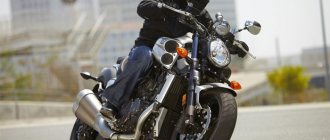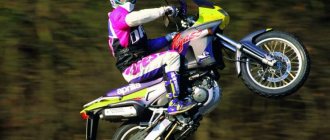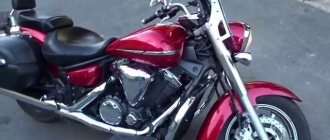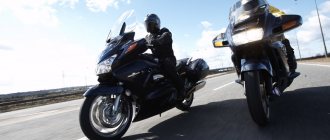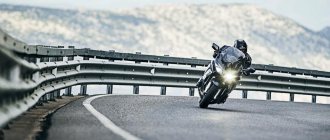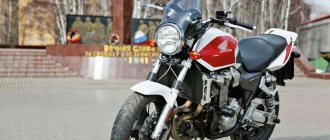- motorcycle model, Yamaha brand,
The Yamaha FJR 1300 sports tourer model was first introduced in 2001 as a successor to the obsolete version of the Yamaha FJ 1200. Despite the stated continuity, the FJR 1300 model has become a completely independent development and has nothing in common with the previous FJ1100/FJ1200 models. From the very beginning, the motorcycle positions itself as the flagship sport-tourer in the Yamaha line of models, intended for sales in foreign markets - in particular, Europe and North America. In addition, the Yamaha FJR 1300 was officially available in a number of other countries - for example, in Oceania and South Africa.
The Yamaha FJR1300 was based on an in-line 4-cylinder liquid-cooled injection engine with a capacity of 1298 cc. see, producing 143 hp. power and 134 Nm of torque. In 2013, the catalysts were optimized and maximum power increased to 146 hp and torque to 138 Nm. Maximum engine performance is achieved at 7000-8000 rpm. Despite the outstanding technical characteristics, the official fuel consumption is stated at 6.2 l / 100 km.
Other features of the Yamaha FJR1300 include an aluminum frame, the ability to electronically adjust the suspension (AE version since 2013), cruise control, an electrically adjustable windshield, seat height adjustment, a combined braking system with ABS, and the availability of versions with a semi-automatic transmission (electronic clutch on AS/AE versions), traction control system, 6-speed gearbox (from 2021), 25 liter fuel tank, cardan drive and 275 kg curb weight.
Main generations of Yamaha FJR 1300:
2001-2002 - first generation. Models of these years do not have ABS, are equipped with 298 mm brake discs (from YZF-R1) and do not have an immobilizer.
2003-2005 - second generation. The motorcycle receives new 320 mm front brake discs, an ABS system (standard in the European market) and an immobilizer.
2006-2012 - third generation. In addition to visual changes, the model receives ABS as standard equipment in the markets of all countries, modifications AE (North America) and AS (Europe) with a semi-automatic transmission appear, the gearbox ratio changes slightly, and a new generator with 590 watts (instead of 490) is installed.
2013-2015 - fourth generation. The model receives visual changes and a variety of electronic systems: electronic throttle, cruise control, traction control, Yamaha D-Mode-System, electronic suspension adjustment and inverted forks (on the AS/AE version - with a semi-automatic transmission).
2016+ - fifth generation. The main differences are the 6-speed gearbox, slipper clutch and LED optics. More expensive versions of AE/AS/ES get adaptive headlights.
Yamaha FJR1300: electronic options
ABS
YCC-T - Yamaha Chip Control Throttle (electronic throttle) - since 2013
YCC-S - Clutchless Shift System - FJR1300AE/AS/ES
TCS (Traction Control System) (traction control system) - since 2013
Cruise control (electronic cruise control system) - since 2013
Yamaha D-Mode-System - since 2013
Electronic adjustment suspension (electronic suspension) - AS/AE/ES from 2013
Brief history of the model
2001 - launch of the Yamaha FJR 1300 model. Factory designation - RP04. The model is available for sale in Europe. The motorcycle does not have versions with ABS, is equipped with 2 front brake discs of 298 mm each and has a dry weight of 264 kg. Model: Yamaha FJR1300 (Europe, South Africa). Model code: 5JW1.
Model: Yamaha FJR1300 (France). Model code: 5JW2.
Model: Yamaha FJR1300 (Oceania). Model code: 5JW3.
2002 - the model is officially sold on the American market (as a 2003 model, so it is not described here). Model: Yamaha FJR1300 (Europe, South Africa). Model code: 5JW4.
Model: Yamaha FJR1300 (France). Model code: 5JW5.
Model: Yamaha FJR1300 (Oceania). Model code: 5JW6.
2003 - factory designation - RP08. European versions receive an ABS system as standard, the diameter of the front brake discs increases to 320 mm, and the dry weight increases by 14 kg. In addition, turn signals become integrated with the body, the shape of the windshield changes, and an immobilizer appears. Model: Yamaha FJR1300 / FJR1300A / FJR13R (Europe, South Africa, Oceania). Model code: 5VS1, 5JWA, 5JW9 - Europe, South Africa; 5VS2, 5JWB - France; 5VS3, 5JWC - Oceania.
Model: Yamaha FJR1300R / FRJ1300RC (North America).
2004 - versions with ABS are available in the American market. Factory designation - RP11. The Yamaha FJR 1300 gets a new fuel pump and side panniers are standard equipment. Model: Yamaha FJR1300 / FJR1300A (Europe, South Africa, Oceania). Model code: 5VS6, 5VS7, 5JWG, 5JWF - Europe, South Africa; 5VS8, 5JWH - France; 5VS8, 5JWH - Oceania.
Model: Yamaha FJR1300S/SC, FJR1300AS/ASC (North America).
2005 - no significant changes. Model: Yamaha FJR1300 / FJR1300A, FJR1300AT (Europe, Oceania). Model code: 5VSG, 5VSD, 5VSC, 5JWN, 5JWM - Europe; 5VSE, 5VSH, 5JWP - France; 5VSF, 5JWR - Oceania.
Model: Yamaha FJR13AT/ATC, FJR13T/TC (North America).
2006 - factory designation - RP13. The Yamaha FJR 1300 model is being restyled - a new curved radiator, a new dashboard, and a generator are being installed. In addition, the final drive ratio is changed and changes are made to the motorcycle's aerodynamic elements (to solve the problem of heat dissipation from the rider). Adjustable vents have also been added to allow you to control airflow, directing it closer or further away from your body. The steering wheel is height adjustable, and the range of windshield adjustments increases. The ABS system (and the combined UBS braking system) became standard equipment on motorcycles in all countries. The appearance of modifications with semi-automatic transmission - Yamaha FJR1300AE (USA, Canada), Yamaha FJR1300AS (Europe). Model: Yamaha FJR1300A / FJR1300AS, FJR1300AV/AEV (Europe, Oceania). Model code: 2D21, 2D26, 3P61, 3P66 - Europe; 2D22, 3P62 - France, Belgium; 2D23, 3P63 - Oceania.
Model: Yamaha FJR13AV/AVC, FJR13ACV, FJR13AEV/AEVC (North America).
2007 - no significant changes. Model: Yamaha FJR1300A / FJR1300AS - Europe; Yamaha FJR1300AW/ASW - Oceania. Model code: 2D27, 2D2C, 3P67, 3P6C - Europe; 2D28, 3P68 - France, Belgium; 2D29, 3P69 - Oceania.
Model: Yamaha FJR13AEW/AEWC, FJR13AW/AWC (North America).
2008 - more advanced ABS is installed on motorcycles. Model: Yamaha FJR1300A / FJR1300AS / AX - Europe; Yamaha FJR1300AX/ASX - Oceania. Model code: 2D2D, 2D2J, 3P6D, 3P6J - Europe; 2D2E, 3P6E - France; 2D2F, 3P6F - Oceania.
Model: Yamaha FJR13AXB/AXCB, FJR13AEXS/AEXCS (North America).
2009 - no significant changes. Model: Yamaha FJR1300A / FJR1300AS / AY (Europe). Model code: 2D2R, 2D2V, 2D2K, 3P6K, 3P6V, 3P6R.
Model: Yamaha FJR13AEYG/AEYCG, FJR13AYB/AYCB (North America).
2010 - version with semi-automatic transmission (Yamaha FJR1300AE) is not sold in the American market. Model: Yamaha FJR1300A / FJR1300AS / AZ (Europe). Model code: 1CY4, 1CY5, 1CY6, 1DA6, 1DA5.
Model: Yamaha FJR13AZS / AZCS (North America).
2011 - version with semi-automatic transmission (Yamaha FJR1300AS) is not sold on the European market. Model: Yamaha FJR1300A / FJR1300AS / AA (Europe). Model code: 1CYE, 1DA9, 1CY9.
Model: Yamaha FJR13AAS/AACS (North America).
2012 - no significant changes. Model: Yamaha FJR1300A / FJR1300AB (Europe). Model code: 1CYH.
Model: Yamaha FJR13ABL/ABCL (North America).
2013 - factory designation - RP23. Versions of the Yamaha FJR1300AS reappear on the European market. In addition, the model gets electronic throttle, traction control system (TCS), cruise control, Yamaha D-Mode-System, faster windshield adjustment mechanism, more advanced aerodynamic elements, LED turn signals and LED lights around the headlights. The AS version received electronically adjustable suspension and an inverted fork. All Yamaha FJR1300 models receive +3 hp. by optimizing catalysts. Model: Yamaha FJR1300A / AS FJR1300AD (Europe). Model code: 1MC1, 1MC5, 1MD1.
Model: Yamaha FJR13ADG/ADCG (North America).
2014 - The American version of the FJR1300 is divided into two - the Yamaha FJR1300A and the Yamaha FJR1300ES. The FJR1300ES is identical to the European FJR1300AS - it is equipped with a semi-automatic transmission, has an electronically adjustable suspension and an inverted fork. Model: Yamaha FJR13AER/AECR, FJR13ESER/ESECR (all markets). Model code: 1MC9, 1MCA (FJR1300A); 2PD1, 2PD2 (FJR1300AE)
2015 - no significant changes. Model: Yamaha FJR13AF/AFC, FJR13ESF/ESFC (all markets). Model code: 1MCG, 1MCH (FJR1300A); 2PD9, 2PDA (FJR1300AE); 1MD4, 1MD5 (FJR1300AS) —
2016 - factory designation - RP28. The model receives a 6-speed gearbox, slipper clutch and LED optics. Top versions (AS, AE) receive adaptive headlights. Model: Yamaha FJR1300A/AE/AS/ES (all markets). Model code: B881 (FJR1300A); B961 (FJR1300AE); B951 (FJR1300AS) -
2017 - no significant changes. Model: Yamaha FJR1300A/AE/AS/ES (all markets). Model code: BK56, BK57, B88B (FJR1300A); B96A, B967, B968, B969 (FJR1300AE)
2018 - no significant changes. Model: Yamaha FJR1300A/AE/AS/ES (all markets). Model code: B88C, (FJR1300A); B96B (FJR1300AE); B954 (FJR1300AS)
2019 - no significant changes. Model: Yamaha FJR1300A/AE/AS/ES (all markets).
2020 - no significant changes. Model: Yamaha FJR1300A/AE/AS/ES (all markets).
2021 - no significant changes. Model: Yamaha FJR1300AE/ES (North America, Australia).
Greetings to all those wintering, Happy Holidays to you! I read a post about the FZ1, a review from someone who owned it. I decided to write my story about the FJR1300 in the same format.
We often look for information on the Internet when we want to buy something new for ourselves, or we just want to read other people’s impressions of a motorcycle like ours, or impressions and reviews of the operation of other motorcycles. And we are especially happy when we find a detailed review, where all the pros and cons from all sides are laid out on the shelves. Otherwise, you have to snatch bits and pieces from the forums, try to put everything together yourself, and the end result is a mess. I myself have encountered this more than once, including in the motorcycle field. I looked for sensible, high-quality reviews on Russian-language resources, read foreign magazines, and this is what I can say: there is little information in Russian. And that’s why I wanted to tell you the story of the selection, purchase, and operation of the Yamaha FJR1300 motorcycle, 2008. I'll try in order.
The path to the tourist Many, including me, came to the choice of motorcycles of this class quite consciously. I was riding an old ’95 Yamaha TRX850. And the longer I rode it, the more I understood what exactly I wanted and what was not in the motorcycle I ride. The first point: wind protection. Yes, there was a fairing, but the head was not protected from the wind in any way and the constant annoying noise on long roads was very tiring. I saved myself with earplugs, but this is not a panacea; you take off your helmet at gas stations and talk as if to yourself. Second point: passenger. My girlfriend should be awarded an Iron Bath for being able to ride on a TRX pole almost 1100 km to Naberezhnye Chelny (one way) 3 times there and back, and to Brest once. But in the 21st century, masochistic tendencies make no sense. Therefore, I wanted a human seat in the back, and freedom for me as a driver. Third point: Luggage. I hung textile bags on Tyrych, and they seemed to do a good job, but they rubbed plastic without frames. And they didn’t interfere that much.
And I decided for sure that I needed a tourist, without any deviations towards “sport” or “enduro”. The choice fell on... No, they didn’t guess. For Honda Pan-European ST1300. I started studying forums, equipment sales sites, and reading reviews. And everything went towards buying this particular motorcycle. But then a new twist awaited me.
Purchase history Night. August. 21st. My friends and I are traveling in the Kitay-Gorod metro area. On Lubyansky Proezd, the clutch cable of my TRX breaks in the left lane in the middle of the road. In short dashes we reached the side of the road, and then there were upset faces, a sleep-deprived tow truck driver, and what seemed like a very long road from the center to the region to Lyubertsy. I drove and thought why all this happened. In the morning I got up and started looking for cables in Moscow. I couldn’t find any suitable length, so I didn’t buy repair kits. After half a day of searching, I decided that this was a sign. I ordered the cable from Japan. While he was driving, he decided to buy a new motorcycle. I’m calling from an advert for the same Pan-Europe that I liked, the color is dark burgundy, the saddlebags are all original, clean, well-groomed, the handles are warm, extra light, fresh tires, we’re talking. It turned out that she did not have ABS, I was upset. The option is gone. Of all the others that were presented, either I didn’t like the color, or it was a complete collective farm, or the price was above the budget of 600 rubles. And below there is an advertisement for the sale of FJR1300.
I'm calling. We agreed to meet. On Saturday, the 22nd. I take a friend, some money, and let’s go have a look. At first, I must admit honestly, the owner did not inspire confidence in me, he was in a hurry, but then we talked normally and are still communicating, Thank you Seryoga for this motorcycle. In general, I calmly looked at the motorcycle, listened to how it worked, and touched it. Sanya's friend hit all the bases for theft/bail/fines. Special thanks to him for this! Later I checked it on Autocheck and CarFax, unfortunately there is very little information on Carfax, there is much more and more detail on Autocheck. The first record was made in 2010 at some dealer, in general, something like the first MOT 1000. And then about 8 service records, then in 2012 he left the USA and came to us. Well, then I say “I like it. I'll take it. Here's the money, let's go get registered." We are going to Pererva. Time 18-00. It's too late, all the tickets are already taken. Early Sunday morning we go to Butovo. We re-register, and that’s it. He is mine.
First impressions So, I get the keys and get dressed. I sit down. What a cruel thing. What do we have to do? It is big, heavy, and moderately tall. I plug in the first one, and... The first emotion is, I don’t understand, is there an electric motor here? I left the Moscow Ring Road, I was driving, I accelerated, it howled like a vacuum cleaner, the traction was smooth, the acceleration was strong, but I couldn’t hear the engine. Long-drawn U-i-i. Anyone who has driven or heard how cars with a drive supercharger sound, this is something close. You can watch videos on YouTube and listen. In general, I drove along the Moscow Ring Road to home in a very calm mode, 100-110, but only halfway through the journey I realized that I was looking at miles. Later I got used to it. And now, in order, I’ll probably start with the heart, which I undeservedly called a vacuum cleaner.
Engine Some numbers: 1300 volume, 135.5 Nm at 7000. Of these, 100 Nm are available at 3500 rpm, 145 hp at 8000. I already said that when I started, I got the impression that I was driving on electric power. In addition to the sound, what also added to this piggy bank was the fact that there are absolutely no sudden pick-ups, jerks, or anything else that could give away the gasoline nature. An absolutely smooth engine, with pleasant low-end traction, a very lively midrange, and a pleasant sound at idle. I turned it above 7 thousand times twice, I can say that there is a lot of power there, but there is absolutely no need for such revolutions. In terms of speed, 3500-3700 coincides with my favorite cruiser 110 km/h. So I travel far. Further 140 km/h is 4500-4800. Beginning of the engine's most optimal operating range.
An interesting point concerns fuel consumption. I always travel with three panniers. On the road from Arkhangelsk, on perfectly smooth asphalt, albeit with constant overcoming of hills and descent from them, the consumption was 4.75 liters per 100 km (62 miles). The speed was kept at exactly 100 km/h, right on the bolt on the speedometer, who fjr, will understand. A tank of 25 liters was then enough for 504 km.
But, when driving 140 km/h with a passenger, the consumption is 40mpg, which is almost 6 liters. Further more and more interesting. 180 km/h with a passenger, 19-25 mpg, that’s 9-10 liters. If there is acceleration up to 220, then it’s already 14-18 miles per gallon, or 13-15 liters. For myself, I have already said that I keep the speed at 110, a habit from Tatarstan where I often travel and where they stuck cameras like bushes on the boulevard. I keep my consumption within 44-48 mpg, 5-5.9 liters per hundred. As for traffic jams, in the city I cannot measure the consumption objectively, because there are many factors that affect this. But I can say that I fill up once every 250-280 km. At the same time, most of the time I stand with the machines and am not in a hurry. At first I filled in gasoline at 95, then switched to 98. There is no difference, just the whim of the owner. Of course, you can come up with something that works softer, quieter and eats less. I won’t, although I have thoughts.
Transmission This model has a 5-speed gearbox. I can’t say anything special about it, my second motorcycle also has a five-speed, so everything is familiar. But there are several nuances. The first one turns on loudly, the kids stop crying, the birds stop singing, the grandmothers stop discussing something on the benches, people get out of their cars to see what happened, passers-by offer help, and so on. It's actually just a loud clack. Kind of a feature. Next: I read on the forums about the second gear falling out. I drive calmly, I’ve never been a racer, that’s why I’m on the second bank. By the way, I think that the issue here is in the manner of using the box. Turning the first one and crunching the second one in at high speeds on a heavy motorcycle will, of course, lead to the loss of gear teeth. I also want to note that fifth gear is long and stretched. If you need to really quickly accelerate on the move, it’s better to stick in the fourth one. But in most cases, you don't need to shift down while on the road. In general, the box works clearly and clicks correctly. I can’t really say anything good or bad about her.
Frame and suspension As far as I know, the frame has not undergone any significant changes since the start of production.
It is quite rigid, made of aluminum. But I would like to separately mention the subframe and the attachment of the rear case to this subframe. The problem concerns motorcycles of the 06+ generation. There have been cases where they have cracked due to a design flaw. While moving, the case creates a large lever of influence on the subframe platform, and gradually the metal bursts in this place. It’s a matter of time before it bursts on me, but for now it’s intact. Solved by boiling and strengthening. By the way, competitors such as Kawasaki GTR and Pan-Europe do not have this problem. By pendants. The front fork on models from '06 has been changed. An additional guide has appeared and the characteristics have been slightly changed. I like the way the front suspension behaves, collected and precise. Swallows small bumps without transmitting them to the steering wheel. But at the same time, the feedback is good and you always understand what is happening with the wheel, what surface it is running on. Good balance of quality. There is one peculiarity: when driving over speed bumps, you can hear the sound Psss, on compression, I still don’t understand where it came from. And a slight click when braking. As for the click, using scientific research, with the help of Sasha Shuba, it was found out that the brake discs click. Kind of a feature of this generation. Consumables for the fork are quite expensive, but they can be found in Moscow and are always in stock. After trips to Arkhangelsk and Tatarstan, I rebuilt the fork because there seemed to be a trace of oil on the left feather, and out of harm’s way I installed everything new. It came out to 10 thousand spare parts and 5 thousand labor. With the third guide you need to have a special one. mandrel. Otherwise, it won't be possible to push it in. The tires were American Avon. Good tires, but when replacing them I made a mistake with the marking and bought the same Avon, but for sports motorcycles, with a load index of 55W (maximum per wheel 218 kg), and a soft compound.
Considering that according to the weight distribution of the FJR, 200 kg hangs on the front wheel, and when sitting on it, even more, and loaded and at the moment of braking - up to two times more, after 8000 km the tire was gone, or rather, it was there, only he chewed it up with a saber around the edges, to such an extent that the steering wheel began to vibrate. It was cured by replacing it with the correct one. The rear shock absorber is a disease of all Rus', all heavy tourers, etc. After 14 thousand km under me, a trace of oil appeared on the rod. At first I thought it was getting cold, I rode in minus -1, maybe from the cold. But I knew from TPKH where I was sorting out the shock absorber in a specialized office that it would only get worse. A motorcycle rides for at least 5 years, and lives even longer. It is not surprising that such parts are falling into disrepair. I bought a new one. Put. A good option was found on Ebay. There is nothing special to say about the shock absorber itself; it is adjusted using a spring from below, and a switch on the side on the left hand of the driver, two positions - Soft and Hard. Works. The difference is noticeable. In the software with a passenger and cargo, the rocking is as if you can’t catch the glider on a boat. It disappears on hard. One can go to the software.
Brakes Combined with ABS. You push the rear, the right caliper brakes in front. If you press the front, the system transfers the desired moment back. In general, many motorcycles already have all this, I think you are familiar with it. There are enough brakes for such a mass always, everywhere. Considering that I drive calmly, even more so. Among the features: there are 8 pads on the front. Little ones. Replacement also costs a pretty penny. Relatives are worth Nissin. They brake quite well. I ordered another set of original pads, and bought Chinese ones from Ebay for testing. For 500 rubles a pair. The set cost 2000 rubles. I set it up, it slows down. But after 2-3 braking from 200 to 120, braking becomes weak. They float violently due to overheating. For measured city driving I didn’t feel any difference. As for Abs. It works smoothly, it worked a couple of times in cold weather on dust. Insures. It's good that there is. In my opinion, a motorcycle should have ABS. Preferably with traction, but unfortunately it was not installed in this generation. Although my wheel has never slipped.
Appearance, fit and wind protection The bike is beautiful. In my opinion. Smooth lines, massive plastic body kit. For some reason, several people completely unrelated to the motorcycle topic asked: is this a scooter? I realized for myself that the similarity is in the headlights. Looks like some common Sym model. There is something in common. From the front it also looks like an overfed Phaser. Or Phaser looks like a thinner FJR, depending on who you want.
As for wind protection, I would like to separately mention the high glass, National Cycle seems to be a company. A very convenient thing, especially considering that the glass is electrically adjustable. I had two scenarios for using it. In traffic jams, when the glass is dirty or very wet, I lowered it to minimum to look at the road without glass, it’s more comfortable. In all other cases, I drive with it raised to maximum. There is no wind at all. Sorry, but the cap didn't come off at two hundred. I won't do this again. There are gills on the side of the plastic; if you open them, your legs will become a little warmer, the engine will be cooler, and there will be no wind on your knees at all. Convenient thing.
Interesting point. Winds “in the cabin” are 80 km/h more than 120. The wind protection starts working fully from 100. As for the landing, I can say that it is absolutely straight, thanks to special spacers under the steering wheel. The seat is height adjustable, I drive with it lowered to the bottom position. My height is 180, I do not touch the tank itself with my knees, since they are lower and touch the gray lining below the tank. This is good, because after three seasons on the TRX, the paint has deteriorated from the knees... The legs are comfortably bent and do not go numb even after 18 hours behind the wheel. There’s also no particular load on the back; in general, I read somewhere that a good motorcycle deserves to meet old age. That's probably true. The seat had built-in heating for both me and number two. Heating is quite simple, with one temperature, but very well chosen. Emelya UK. The seats were reupholstered, the shape remained the same, but a small backing was added for softness. Which, coupled with heating handles and side deflectors, will make it possible to drive at night and not freeze. I installed the handles with Dice, their regulator is cool, and it fits in the normal place. They heat well, the adjustments work.
Separately, I would like to note the very comfortable mirrors and their very good visibility. You can really see everything, with virtually no dead zones.
Luggage My fizher initially had a small central case, and after the purchase everyone laughed at me, even the motorized battalion; the first thing they did was not ask for documents, but ask the question: “What’s wrong with the case?” As a result, I developed the complex of a small trunk, and I already knew where I would spend the next 25 thousand. The original center case is surprisingly small inside, and at first I liked the way it looked on the outside, but lately it seems like some kind of box. And there are often cases when it flew off on the way due to the peculiarities of the fastening. One of my friends, Denis, also the owner of the same FJR, advised me to look at the Carra panniers, practical, inexpensive, and with a Monochrome givish fastening. I looked and looked, and in the end I liked the Givi V47 case. And in black and gray colors, it looked like it was made to match my motorcycle. I bought it in one salon on Shchelkovskaya at a discount for 23 thousand, along with a platform and a backrest for it. I also bought a bag for the tank there, which is attached to the neck. I bought not the smallest one, but 8 liters, more.
Now it’s convenient, you don’t have to get off the loaded motorcycle when you’re stopped at checkpoints, I took it out, showed it, and moved on. And it's just convenient. The FJR also has a glove compartment on the front left. It contains a cigarette lighter socket. The glove compartment is locked when the key is removed from the ignition. Before the tank bag, I carried mobile phones there. The iPhone 6 fits in absolutely freely and there is still three centimeters to the lid, the width is enough for 10 iPhones, 8-10 centimeters is the width of the glove compartment. The side cases are roomy, the helmet fits in easily. At the beginning of the season, I will make soft padding in them so as not to scratch, for example, the same helmet. The panniers are locked with a motorcycle lock. Easy to remove. Easy to dress. I personally like the look with panniers more than without. I think that Fjr without panniers is like a dog without a tail. Somehow it looks more harmonious with luggage racks in the back, given the massive front part of the motorcycle.
And it's just convenient. The FJR also has a glove compartment on the front left. It contains a cigarette lighter socket. The glove compartment is locked when the key is removed from the ignition. Before the tank bag, I carried mobile phones there. The iPhone 6 fits in absolutely freely and there is still three centimeters to the lid, the width is enough for 10 iPhones, 8-10 centimeters is the width of the glove compartment. The side cases are roomy, the helmet fits in easily. At the beginning of the season, I will make soft padding in them so as not to scratch, for example, the same helmet. The panniers are locked with a motorcycle lock. Easy to remove. Easy to dress. I personally like the look with panniers more than without. I think that Fjr without panniers is like a dog without a tail. Somehow it looks more harmonious with luggage racks in the back, given the massive front part of the motorcycle.
In general, I really like the motorcycle. It combines all the necessary qualities for convenient movement from point A to point B. As one of my good friends said: “This motorcycle has nothing special, just a means of transportation.” Absolutely agree. Moreover, in our lives we are surrounded by unremarkable objects that simply do what they were designed for, the TV broadcasts programs to us, the phone in our pocket rings, the kettle boils water, the lamp shines, and the FJR simply takes you safely and comfortably to any point where there is a good road. It's like a company car in a company park, but you can't say it doesn't have a soul. It exists, it’s just that he can’t express it so brightly. And not for everyone.
There are a lot of brighter and more charismatic motorcycles, but that's another story.
Specifications:
| Model | Yamaha FJR 1300 |
| Motorcycle type | Sports tourist |
| Year of issue | 2001- |
| engine's type | 4-cylinder, 4-stroke, in-line |
| Working volume | 1298 cc cm. |
| Cooling | Liquid |
| Bore/Stroke | 79 mm x 66.2 mm |
| Compression ratio | 10,8:1 |
| Number of valves per cylinder | DOHC, 4 valves per cylinder |
| Fuel supply system | injector, 4x Mikuni 42EHS |
| Ignition type | TCI: Transistor Controlled Ignition |
| Maximum power | 146.2 hp at 8000 rpm (until 2013 - 143.4 hp) |
| Maximum torque | 138 Nm at 7000 rpm (before 2013 - 134.4 Nm) |
| Transmission | 6-speed (until 2021 - 5-speed) |
| type of drive | cardan |
| Frame | aluminum, diamond-shaped |
| Front suspension | 48 mm telescopic fork (all adjustable), travel - 135 mm (from 2013 AS/AE - inverted fork) |
| Rear suspension | Pendulum with monoshock absorber (adjustable preload and rebound), stroke - 125 mm |
| Front tire size | 120/70 ZR17M/C (58W) |
| Rear tire size | 180/55 ZR17M/C (73W) |
| Front brakes | 2001-2002: 2 discs, 298 mm, 4-piston calipers 2003-2005: 2 discs, 320 mm, 4-piston calipers (optional ABS) 2006+: 2 discs, 320 mm, 4-piston calipers (ABS+UBS) |
| Rear brakes | 2001-2002: 1 disc, 282 mm, 2-piston caliper 2003-2005: 1 disc, 282 mm, 2-piston caliper (optional ABS) 2006+: 1 disc, 282 mm, 2-piston caliper (ABS+UBS) |
| Acceleration 0-100 km/h | 3.2 sec |
| Maximum speed | 249 km/h |
| Overall dimensions (LxWxH) | 2001-2005: 2195 x 760 x 1435 mm 2006+: 2230 x 750 x 1455 mm |
| Seat height 2001-2005: 800 mm | 2006+: 805-825 mm (adjustable) |
| Wheelbase | 2001-2005: 1515 mm 2006+: 1545 mm |
| Gas tank capacity | 25 l (including reserve - 5.5 l) |
| Motorcycle weight (curb) | 275 kg - FJR1300 (2001-2005) 282 kg - FJR1300A (2003-2005) 291 kg - FJR1300A (2006+) 295 kg - FJR1300AE/AS (2006+) |
Yamaha FJR1300 60,000km mileage - owner review
Page 1 of 2
It seemed strange that for 4 years now our faithful friend Yamaha FJR1300 has been serving us faithfully, and not a single page on the site is dedicated to it, which is being developed thanks to it - Yamaha FJR1300. No sooner said than done. I can say without a twinge of conscience that the Yamaha FJR1300 is a hit among touring motorcycles. The Yamaha FJR1300 combines a lot of advantages for a motorcycle touring enthusiast - universal, comfortable for long-distance travel and with a sportbike character. During operation, which is 60,000 km. mileage - the Yamaha FJR1300 has earned only positive reviews!
Yamaha FJR1300 - 60,000 km mileage. Owner's review.
Rate -
!
The geography of trips on the Yamaha FJR1300 - from Nordkapp (Nordkapp - the northernmost point of Europe) - to travel through Africa, including the westernmost point of Europe - the Cape. Roca and Italian Sicily. I’m writing my review about the motorcycle I’ve been riding for 5 years - Yamaha FJR1300 and this is not an article about a 1-2 hour test drive for a magazine...
It was put into the garage in the late autumn of 2008, with a mileage of 18,000 km, a 2003 model, and in the early spring of 2009. The Yamaha FJR1300 was already on its way to see Europe.
The FJR1300 engine is an in-line four; no shortcomings were noted in the engine. Powerful (144 l/s!) and smooth in performance, reliable, flexible and economical, with an extremely low level of vibration (and two balancer shafts!). The FJR1300 engine has excellent traction performance: it delivers 80% of the torque in the range from 2750 to 8750 rpm. In the mountains it pulls calmly with a passenger and luggage in 4th or 5th gear.
Acceleration to hundreds - 3 seconds, i.e. lifts the front wheel and confidently reaches 200, I didn’t accelerate more than 245 km/h, because... If there are decent roads, I always travel with panniers, luggage and a navigator.
At 30,000 km. The throttle position sensor started to malfunction - it was replaced in the Czech Republic under Yamaha warranty for free! Considering the large volume of the fuel tank (28 liters), you can travel 400 km on one fill-up if you keep the speed at 100-160 km/h. Several times on the road I almost dried out, driving into a gas station on the last drops. The FJR1300's fuel consumption and tank capacity are a definite plus. The stability of movement is beyond praise.
The FJR1300 gearbox is precise, but you need to get used to it when switching to neutral - it is very gentle. When accelerating, I intuitively constantly try to engage 6th gear, which, alas, is not there... In the latest models, the gear ratios have been changed, and in 5th gear at 3000 rpm the speed is not 80 km/h, but more (I don’t remember how much). The clutch drive is hydraulic.
Suspension FJR1300 - both suspensions are equipped with adjustments for compression and rebound, have a very wide range of settings - the monoshock spring preload lever from the "Hard" to "Soft" position can be moved by hand in 1 second when there is no load on the motorcycle standing on the side stand. The fork is powerful and torsionally rigid – 48 mm. The fluid was changed at 18,000 km (after purchase) and washed at 70,000 km.
The brakes of the FJR1300 are equipped with ABS, you press and don’t think about what’s under you – you press as much as you need. The pads can be easily changed when traveling. On motorcycles before 2003 no ABS and front wheel brake discs have a 20mm smaller diameter. The FJR1300 frame is made of diagonal aluminum alloy - light and rigid, with a powerful subframe.
Side cases FJR1300 (original) - beautiful plastic, waterproof, conveniently detachable for taking into a hotel, ergonomic and very expensive... Because of their tricky shape, it is difficult to place rectangular objects. Capacity is average. It’s quite convenient to load 30L Lewis trunks on top. using the tension strap.
The original FJR1300 center case sucks. Only 1 helmet fits into it, although it looks very voluminous in appearance, but the double walls (like the side cases) eat up all the useful volume. I received the FJR1300 without the center case.
Wind protection FJR1300 - the rise of the adjustable glass is not enough by 5-10 cm to cut off the air flow at speeds of 140-180 km/h, it can be treated by installing a homemade wind deflector (it can be seen in all photographs). The passenger suffers a little after 170 km/h - the wind blows his head around. At lower speeds - everything is fine, the passenger can even doze while sitting as if on a throne - there are trunks on the sides, and the central trunk is held at the back. When it rains, the driver's shoes get wet - this can be treated by installing a cut-off valve.
The heat from the engine in the place where the legs grow is a minus, it is felt only in warm weather during a long trip and when driving around the city.
Who did Yamaha create this FJR1300 for? For those who lack sportsmanship in tourists, and for sports - the comfort of a tourist, for those who want to move quickly and comfortably in space.
Because Over 60,000 km of mileage, no flaws have been identified in the Yamaha FJR1300, but minor features have been identified:
- does not drive on slippery roads, snow, wet clay or sand - it either falls or gets stuck; — low ground clearance — it’s problematic to drive through fields and potholes; - the weight of a fully loaded motorcycle is large - it is difficult to steer off-road; - the engine power can probably be less - the power reserve is excessive, and given the state’s “love” for motorcyclists in the form of tax rates that are multiples of power, then having a motorcycle with a power of over 100 hp is risky for the family budget.
After identifying all the shortcomings, a reasonable question arises: What should I buy instead of the Yamaha FJR1300?
Answer:
Yamaha FJR1300 latest model.
Main characteristics of Yamaha FJR1300
- Engine: 1298 cm3, 4-stroke, 4-cylinder, in-line, DOHC, 16 valves, liquid cooling
- Maximum power: 144 hp. With. at 8500 rpm
- Maximum torque: 134 Nm at 7000 rpm
- Length: 2195 mm
- Base: 1515 mm
- Dry weight: 237 kg
- Front tire: 120/70–17
- Rear tire: 180/55–17
Reports on trips on the Yamaha FJR1300 in the section - Travel on the ground Movies about trips on the Yamaha FJR1300 in the section - DVD-video & Blu-ray
Photos of Yamaha FJR1300 on motorcycle trips:
Yamaha FJR1300, motorcycle review, test drive, mileage, best motorcycle, cardan, speed, photos
- Forward

